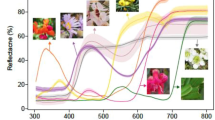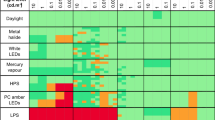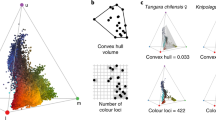A combination of colour and polarized reflections helps them to choose oviposition sites.
Abstract
Light can be described by its intensity, spectral distribution and polarization, and normally a visual system analyses these independently to extract the maximum amount of information1. Here I present behavioural evidence that this does not happen in butterflies, whose choice of oviposition substrate on the basis of its colour2 appears to be strongly influenced by the direction of polarization of the light reflected from the substrate. To my knowledge, this is the first record of ‘false’ colours being perceived as a result of light polarization. This detection of false colours may help butterflies to find optimal oviposition sites.
This is a preview of subscription content, access via your institution
Access options
Subscribe to this journal
Receive 51 print issues and online access
$199.00 per year
only $3.90 per issue
Buy this article
- Purchase on Springer Link
- Instant access to full article PDF
Prices may be subject to local taxes which are calculated during checkout

Similar content being viewed by others
References
Nilsson, D.-E. & Warrant, E. J. Curr. Biol. 9, R535–R537 (1999).
Kelber, A. J. Exp. Biol. 202, 2619–2630 (1999).
Schwindt, R. J. Comp. Physiol. A 169, 531–540 (1991).
Wehner, R. & Bernard, G. D. Proc. Natl Acad. Sci. USA 90, 4132–4135 (1993).
Shashar, N., Cronin, T. W., Wolff, L. B. & Condon, M. A. Biotropica 30, 275–285 (1998).
Arikawa, K. & Uchiyama, H. J. Comp. Physiol. A 178, 55–61 (1996).
Marshall, J., Cronin, T. W., Shashar, N. & Land, M. Curr. Biol. 9, 755–758 (1999).
Land, M. F. Nature 363, 581–582 (1993).
Roijas, J. C. & Wyatt, T. D. Entomol. Exp. Appl. 91, 59–65 (1999).
Author information
Authors and Affiliations
Corresponding author
Rights and permissions
About this article
Cite this article
Kelber, A. Why ‘false’ colours are seen by butterflies. Nature 402, 251 (1999). https://doi.org/10.1038/46204
Issue Date:
DOI: https://doi.org/10.1038/46204
This article is cited by
-
Behavioral responses of free-flying Drosophila melanogaster to shiny, reflecting surfaces
Journal of Comparative Physiology A (2023)
-
Brightness mediates oviposition in crepuscular moth, Grapholita molesta
Journal of Pest Science (2020)
-
Fine nanostructural variation in the wing pattern of a moth Chiasmia eleonora Cramer (1780)
Journal of Biosciences (2018)
-
Polarisation vision: overcoming challenges of working with a property of light we barely see
The Science of Nature (2018)
-
Neurons in the brain of the desert locust Schistocerca gregaria sensitive to polarized light at low stimulus elevations
Journal of Comparative Physiology A (2016)
Comments
By submitting a comment you agree to abide by our Terms and Community Guidelines. If you find something abusive or that does not comply with our terms or guidelines please flag it as inappropriate.



